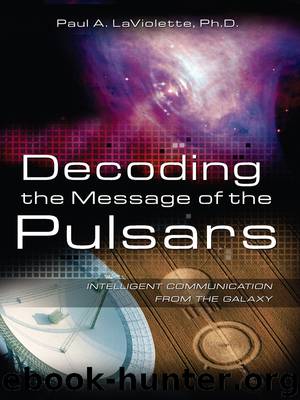Decoding the Message of the Pulsars: Intelligent Communication From the Galaxy by Paul A. Laviolette

Author:Paul A. Laviolette
Language: eng
Format: mobi
Tags: Body, Technology & Engineering, Astrophysics, Science, Cosmology, Ancient Mysteries & Controversial Knowledge, Mind & Spirit, Astronomy, Physics, Aeronautics & Astronautics
ISBN: 9781591430629
Publisher: Bear & Company
Published: 2006-04-20T12:00:00+00:00
Is the Degree a Galactic Standard of Angular Measurement?
Dividing the orbital radius of the EBM Pulsar (0.0892267 light-second) by the period of the Millisecond Pulsar (0.001557806 second) yields the ratio 57.2772, a number that is within three hundredths of a percent of the number of degrees in one radian (57.2958). In this indirect fashion, these two pulsars could be expressing the one-radian concept. However, since the EBM pulsar’s partner star is losing mass, its influence on the pulsar will be gradually decreasing, so the pulsar’s orbital radius should also be gradually decreasing. At some time in the past, then, the pulsar’s orbital radius in light-seconds would have been 29 micro light-seconds longer, making it large enough for this ratio to be numerically equal to the number of degrees in a radian. Knowing that the binary’s orbital period is increasing at the rate of 3.8±10 x 10-6 percent per year, we can estimate that the pulsar’s orbital radius would have been 29 micro light-seconds longer 8,500±20,000 years ago, or very roughly around the time of the Vela supernova explosion.
It is also interesting to note that if we take the period of the Vela pulsar and divide it by the period of the Millisecond Pulsar, we find that this period ratio was exactly equal to the number of degrees in one radian in September 1963 and has since been deviating from this value by ~0.002 percent per year due to the gradual increase of the Vela pulsar’s period. We cannot be certain that a galactic commune of intercommunicating civilizations would be using a system of angular measurement that subdivides a circle into 360 degrees. Nevertheless, it is interesting to find that the period ratio of these two unique pulsars equals the number of degrees in one radian. This makes us wonder where our system of a 360° circle originated. Was it taught to us?
Download
This site does not store any files on its server. We only index and link to content provided by other sites. Please contact the content providers to delete copyright contents if any and email us, we'll remove relevant links or contents immediately.
Tools of Titans by Timothy Ferriss(7781)
Turbulence by E. J. Noyes(7685)
Astrophysics for People in a Hurry by Neil DeGrasse Tyson(4992)
Secrets of Antigravity Propulsion: Tesla, UFOs, and Classified Aerospace Technology by Ph.D. Paul A. Laviolette(4966)
Design of Trajectory Optimization Approach for Space Maneuver Vehicle Skip Entry Problems by Runqi Chai & Al Savvaris & Antonios Tsourdos & Senchun Chai(4833)
Room 212 by Kate Stewart(4723)
Pale Blue Dot by Carl Sagan(4605)
The David Icke Guide to the Global Conspiracy (and how to end it) by David Icke(4370)
A Journey Through Divination and Astronomy by Publishing Pottermore(4242)
Apollo 8 by Jeffrey Kluger(3503)
Goodbye Paradise(3430)
Losing the Nobel Prize by Brian Keating(3422)
COSMOS by Carl Sagan(3338)
The Five People You Meet in Heaven by Mitch Albom(3324)
Brief Answers to the Big Questions by Stephen Hawking(3232)
How to Read Water: Clues and Patterns from Puddles to the Sea (Natural Navigation) by Tristan Gooley(3230)
The Order of Time by Carlo Rovelli(3068)
How to Read Nature by Tristan Gooley(3067)
A Brief History of Time by Stephen Hawking(2815)
